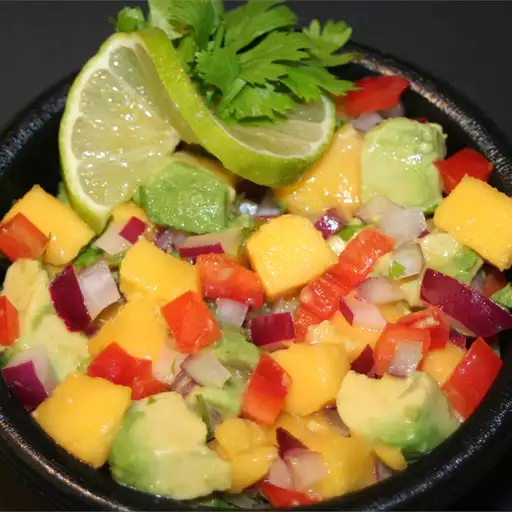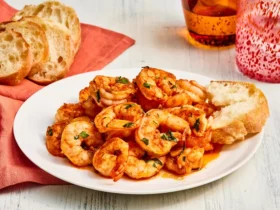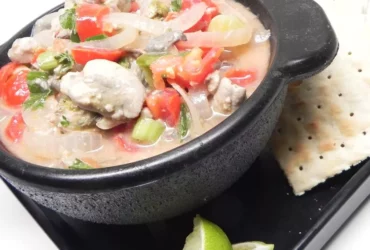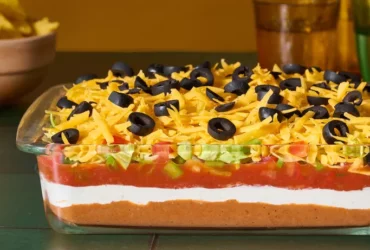Ingredients
Freshness Matters: Selecting the Best Avocados
- When it comes to selecting the best avocados for your Avocado Mango Salsa Recipe, freshness matters greatly.
- The first step is to choose avocados that are ripe but still firm to the touch.
- This can be a bit tricky as avocados continue to ripen after they’re picked from the tree, but some signs of readiness include a slight softening around the stem end and a slight yellowing or reddening of the skin.
- It’s essential to avoid selecting avocados that are too green or unripe, as they won’t mash easily and will be unpleasantly starchy in texture.
- Conversely, choose avocados that have a slight give when pressed gently around the stem end but still feel heavy for their size.
- The skin should also be smooth and even, with no visible bruises or blemishes, as these can indicate damage during handling.
- Avoid avocados with soft or mushy spots, as they may be past their prime or spoiled.
- It’s worth noting that some avocado varieties, like ‘Hass’ or ‘Fuerte’, will be more susceptible to ripening than others.
- If you’re unsure about the ripeness of your avocados, simply leave them at room temperature for a few days to see if they’ll continue to ripen.
- For a delicious and fresh Avocado Mango Salsa Recipe, make sure to choose ripe but firm avocados that will hold their texture when diced.
Choose avocados with a slight give to the touch but still firm
To create the perfect Avocado Mango Salsa, it’s crucial to select avocados that are ripe but still firm to the touch. This will ensure that they hold their shape and provide a silky texture to the salsa.
Ripe avocados typically yield to pressure when gently squeezed, but should not be mushy or soft to the point of being overly yielding. The ideal avocado for this recipe is one that has a slight give when pressed, but still feels firm enough to hold its shape and provide a pleasant mouthfeel.
One way to determine if an avocado is ripe but firm is to perform a gentle squeeze test. Gently press the skin of the avocado in various spots, applying moderate pressure with your thumb or index finger. If it yields slightly to pressure but still feels relatively firm, it’s likely ready to use.
Avoid avocados that are rock-hard, as they may not ripen properly and could end up being too hard and unyielding for the salsa. Similarly, if an avocado is overly soft or mushy, it’s probably overripe and should be discarded.
When selecting avocados from a grocery store or market, choose ones with smooth, even skin that are free of bruises or blemishes. Avoid those with visible signs of decay or mold, as these can impart an unpleasant flavor to the salsa.
The variety of avocado used in this recipe is less crucial than its ripeness and texture. However, popular varieties like Hass, Fuerte, or Bacon will all work well for Avocado Mango Salsa.
Opt for ripe avocados, as they will be easier to mash and blend into the salsa
- To make this delicious Avocado Mango Salsa, you’ll need the following ingredients:
- Ripe avocados: 2-3, depending on their size and your desired level of creaminess in the salsa.
- Mango: 1 ripe mango, diced. You can use either a red or yellow mango for this recipe.
- Red onion: 1/4 cup, diced. You can adjust the amount to suit your taste preferences.
- Jalapeño pepper: 1-2, seeded and finely chopped. Adjust the level of heat to your liking by using one or two peppers.
- Cilantro: 1/4 cup, chopped fresh cilantro leaves.
- Lime juice: 2 tablespoons, freshly squeezed from a lime. You can adjust the amount to taste.
- Salt: To taste. Use a mild or Himalayan pink salt to add depth to the salsa without overpowering its flavors.
The beauty of this recipe lies in the combination of creamy avocado, sweet and tangy mango, crunchy red onion, spicy jalapeño, and fresh cilantro. The ripe avocados will add a rich texture to the salsa, while the mango provides natural sweetness. You can serve this delicious Avocado Mango Salsa with tortilla chips, on top of grilled meats or fish, as a dip for tacos, or even as a topping for omelets and breakfast dishes.
The California Avocado Commission recommends selecting avocados that are heavy for their size
When it comes to selecting the perfect avocados for making our delicious Avocado Mango Salsa, we can rely on some expert advice from The California Avocado Commission. One of their key recommendations is to choose avocados that are heavy for their size. But why is this so important? Let’s break down what it means and how you can put it into practice.
When an avocado is heavy for its size, it typically indicates that the fruit has a higher water content and a more developed flavor profile. This is due to the fact that avocados with more moisture will generally feel heavier than those that are dry or mealy. So, what does this mean in terms of selecting avocados for your salsa recipe? Simply put, it means you should opt for those fruits that have a sturdy weight to them.
But how can you determine if an avocado is heavy enough for your needs? One trick is to gently squeeze the fruit between your thumb and index finger. If it yields to pressure but still feels firm and springy, it’s likely ready to use in your recipe. Avoid avocados that are too soft or mushy, as they may be overripe and will not hold their texture well when diced and mixed with other ingredients.
Another key consideration is the avocado’s color. While some varieties of avocado have a more vibrant green skin, others may have a slightly yellow or even red tint. This does not necessarily impact their flavor or quality, so don’t be afraid to mix and match different types based on your personal preference and what looks appealing at the store.
Once you’ve selected the perfect avocados for your salsa recipe, it’s time to think about the other key ingredients that will bring all the flavors together. In addition to ripe avocados, our Avocado Mango Salsa Recipe features juicy mango, crunchy red onion, and a hint of lime juice, among other tasty ingredients.
Remember, the beauty of this recipe lies in its simplicity and flexibility. Feel free to customize it with your favorite fruits, spices, or herbs to create a truly unique flavor experience that’s all your own! Whether you’re serving our Avocado Mango Salsa as an appetizer, side dish, or even using it as a topping for tacos or grilled meats, we hope you enjoy every last bite.
Preparation
Mango Madness: Preparing the Perfect Mangoes
The sweet and tangy flavors of mango pair perfectly with the creamy texture of avocado, making it a match made in heaven for many fruit lovers.
In order to create the perfect Avocado Mango Salsa, preparation is key. This involves selecting ripe mangoes, cutting them into small pieces, and preparing any other ingredients required for the recipe.
Preparing the Perfect Mangoes
Here’s a step-by-step guide on how to prepare the perfect mangoes for your Avocado Mango Salsa:
- Select Ripe Mangoes: Choose mangoes that are slightly soft to the touch but still firm. Avoid any that are too mushy or too hard.
- Wash the Mangoes: Rinse the mangoes under cold running water, making sure to remove any dirt or bacteria.
- Dry the Mangoes: Gently pat the mangoes dry with a clean cloth or paper towel to remove excess moisture.
- Cut the Mangoes: Using a sharp knife, cut the mangoes in half and then slice them into small cubes.
Now that your mangoes are prepared, you can move on to preparing any other ingredients required for the recipe.
Additional Ingredients Preparation
Here’s a list of additional ingredients you’ll need to prepare:
- Avocados: Cut the avocados in half and remove the pit. Then, slice them into small pieces.
- Red Onion: Thinly slice the red onion and separate it into individual rings.
- Jalapeño Pepper: Slice the jalapeño pepper thinly, making sure to remove any seeds or membranes for a milder flavor.
- Cilantro: Chop the cilantro leaves finely and set aside.
Now that all your ingredients are prepared, it’s time to assemble the Avocado Mango Salsa recipe!
Select a variety of mango that’s sweet and ripe, such as Ataulfo or Haden
To prepare the perfect Avocado Mango Salsa for your recipe, you’ll want to start by selecting the right variety of mango that’s sweet and ripe.
There are several types of mangoes available, but some popular options include:
- Ataulfo: This Mexican variety is known for its unique, sweet flavor and smooth texture. It’s a great choice if you want a more subtle mango taste in your salsa.
- Haden: Another popular variety from Mexico, Haden mangoes are larger than Ataulfo and have a slightly sweeter taste. They’re also easier to find in many supermarkets.
When selecting your mango, make sure to choose one that’s heavy for its size and has a sweet, slightly tangy aroma. Avoid any mangoes with brown or soft spots, as these can indicate over-ripeness.
To ripen an unripe mango at home, place it in a paper bag with an apple or banana (which produce ethylene gas, helping to speed up the ripening process). Store the bag in a cool, dark place and check on the mango every day or two until it reaches your desired level of ripeness.
For the best flavor and texture in your Avocado Mango Salsa, use a combination of ripe Ataulfo and Haden mangoes. This will add depth and complexity to your salsa while still maintaining its sweet and tangy taste.
Use a melon baller to scoop out the flesh from around the pit
- To prepare your ingredients for the Avocado Mango Salsa Recipe, you will need to carefully extract the flesh from an avocado and a melon.
- A melon baller is a kitchen tool used specifically for this purpose – to scoop out the fleshy part of fruits like watermelon or honeydew without damaging their exterior rind.
- To use a melon baller to scoop out the flesh from around the pit in a melon, start by gently placing the baller into the center of the melon.
- The curved end of the melon baller is designed to hug the contours of the fruit and easily release the desired amount of flesh.
- Hold the melon firmly in place with one hand and use your other hand to carefully twist and scoop out the fleshy part, making sure not to cut or tear the surrounding rind.
- This process will allow you to extract a precise amount of melon flesh from around the pit without any of it getting wasted or damaged in the process.
According to the University of Florida Institute of Food and Agricultural Sciences, ripe mangoes will be slightly soft to the touch
To ensure that you select ripe mangoes for your Avocado Mango Salsa Recipe, it’s essential to understand how to evaluate their ripeness. According to the University of Florida Institute of Food and Agricultural Sciences, ripe mangoes will be slightly soft to the touch.
Here are some key indicators to check when selecting a ripe mango:
- Softness: A ripe mango will yield to pressure but still feel slightly firm. If it’s too soft, it may be overripe and have a mushy texture.
- Weight: Ripe mangoes are typically heavy for their size.
- Color: The skin of a ripe mango will be a rich yellow or reddish-yellow color, depending on the variety. Some mangoes may also develop a red or pink blush on the cheeks.
- Scent: Ripe mangoes give off a sweet, slightly musky aroma.
It’s worth noting that some mango varieties, such as the Tommy Atkins or Ataulfo, may have a slightly greener skin even when fully ripe. In this case, it’s essential to rely on the softness and weight of the fruit rather than its color alone.
To speed up the ripening process, you can place the mango in a paper bag with an apple or banana. The ethylene gas produced by these fruits will help to ripen the mango more quickly.
Blending the Magic
Creating the Perfect Salsa Consistency
The process of blending the magic in creating a perfect salsa consistency involves a delicate balance between texture, flavor, and temperature.
When it comes to our Avocado Mango Salsa Recipe, achieving the right blend is crucial to bring out the vibrant flavors of the fresh ingredients and create a harmonious balance of textures that will leave your taste buds dancing.
The first step in blending the magic is to ensure that all the ingredients are at room temperature. This helps to prevent any cold ingredients from inhibiting the breakdown of the other components, ultimately resulting in a chunky rather than smooth consistency.
Next, add the ripe avocados and mango to your blender or food processor. The creamy texture of the avocados will provide a rich and velvety base for your salsa, while the sweetness of the mango will add a pop of freshness and tropical flavor.
Add in any additional ingredients such as red onion, jalapeño peppers, cilantro, lime juice, salt, and pepper. The acidity from the lime juice will help to brighten up the flavors and bring out the natural sweetness in the other ingredients.
Now it’s time to blend! Start by pulsing your blender or food processor for a few seconds at a time, checking on the consistency after each pulse. You can also stop the machine and scrape down the sides of the bowl with a spatula to ensure everything is well combined.
The key to achieving the perfect salsa consistency is to blend in small increments, gradually increasing the speed and duration as needed. This will help you avoid over-blending and ending up with a smoothie-like texture that’s lost all its chunky charm.
As you blend, pay attention to the color of your salsa. You’re aiming for a vibrant mix of green from the avocados, yellow from the mango, and red from the jalapeño peppers. If you notice the colors starting to blend together too much or the texture becoming too smooth, stop blending immediately!
The perfect consistency should be chunky but not chunky enough that it’s uncomfortable to eat. It should have a slight “bite” from the fresh ingredients and hold its shape on the spoon when lifted.
Finally, transfer your blended salsa to a serving bowl or container and refrigerate for at least 30 minutes to allow the flavors to meld together. This will help to bring out the natural sweetness of the mango and balance out any acidity in the lime juice.
In a blender or food processor, combine diced avocado, mango, red onion, jalapeño pepper, cilantro, and lime juice
To blend the Magic of flavors, combine the diced avocado with the creamy texture and richness it provides, along with the sweetness and juiciness of the mango. The crunchy bite of the red onion adds a nice contrast to the smoothness of the avocado and mango.
Add in the jalapeño pepper for a touch of heat that will elevate the flavors of the dish. Make sure to remove the seeds and membranes if you prefer a milder flavor, or leave them in for an extra kick.
Next, add in some fresh cilantro, also known as coriander, which will give the salsa its signature bright and herbaceous flavor.
Squeeze in some freshly squeezed lime juice to bring everything together and add a burst of citrus flavor. Be careful not to add too much lime juice, as it can make the salsa too acidic.
Blend all these ingredients together until you reach your desired consistency. You want the salsa to be smooth but still chunky enough to hold its texture.
Taste and adjust the seasoning as needed. You can add more lime juice, salt, or even a bit of sugar to balance out the flavors.
And that’s it! Your Avocado Mango Salsa is ready to be served with your favorite chips, tacos, grilled meats, or veggies. Enjoy the Magic of this delicious and healthy salsa!
Blend until smooth and slightly chunky, according to your desired consistency
- To blend the magic of your Avocado Mango Salsa, you’ll need to achieve a smooth and slightly chunky consistency.
- The goal is to balance the textures of the ingredients so that they complement each other perfectly.
Blending Tips
- Beware of over-blending, as this can result in an unappetizing paste. You want your salsa to retain some texture and freshness.
- Start by blending the softest ingredients first, such as ripe avocados or mango puree.
The Blending Process
Begin with a basic ratio of 3 parts avocado to 1 part mango. You can adjust this ratio based on your personal preference for each ingredient’s presence in the final product.
In a blender or food processor, combine:
- Avocado chunks (about 2-3 ripe avocados)
- Mango chunks (1/2 to 1 ripe mango)
Add the following ingredients in small quantities and blend until smooth:
- Red onion, diced (about 1/4 cup)
- Cilantro, chopped (about 1/4 cup)
- Jalapeño pepper, seeded and finely chopped (about 2-3 tablespoons)
- Garlic clove, minced (about 1-2 cloves)
Now it’s time to adjust the consistency of your salsa. You want it to be smooth enough to coat the back of a spoon, but still retain some chunkiness from the avocado and mango.
The Finishing Touches
- Taste and adjust the seasoning as needed with lime juice, salt, or cumin powder.
- Add additional ingredients like diced tomatoes or shredded coconut to enhance the flavor and texture of your salsa.
Your Avocado Mango Salsa is now ready to be served! Enjoy it immediately or store it in an airtight container in the refrigerator for up to 2 hours before serving.
The United States Department of Agriculture recommends using a consistent texture in salsas for optimal flavor and safety
The concept of Blending the Magic is often associated with the art of creating a harmonious balance between flavors, textures, and presentation, as seen in the creation of the Avocado Mango Salsa Recipe.
For those unfamiliar, blending in this context refers to the act of combining two or more ingredients that complement each other in terms of texture, flavor, and color, resulting in a cohesive and visually appealing dish. The United States Department of Agriculture (USDA) emphasizes the importance of maintaining a consistent texture in salsas for optimal flavor and safety.
This recommendation from the USDA is rooted in the idea that an inconsistent texture can lead to an uneven distribution of flavors, potentially affecting the overall taste experience of the consumer. Furthermore, a varied texture can also increase the risk of foodborne illness, particularly when handling raw or partially cooked ingredients like fruits and vegetables.
When applying this principle to the Avocado Mango Salsa Recipe, it is essential to balance the creamy smoothness of the avocado with the juicy sweetness of the mango. The resulting salsa should have a uniform consistency that is neither too chunky nor too pureed, allowing each bite to showcase the optimal flavor profile.
By blending the magic of textures and flavors in this Avocado Mango Salsa Recipe, cooks can create an authentic Mexican-inspired condiment that complements various dishes, from tortilla chips to grilled meats and vegetables. By paying attention to texture and maintaining a consistent blend, enthusiasts can elevate their culinary experience while prioritizing food safety.
- Best Dun & Bradstreet (DNB) Alternatives for 2025 - April 24, 2025
- Best Seamless.ai Alternatives for 2025 - April 22, 2025
- Best Coldlytics Alternatives for 2025 - April 22, 2025















